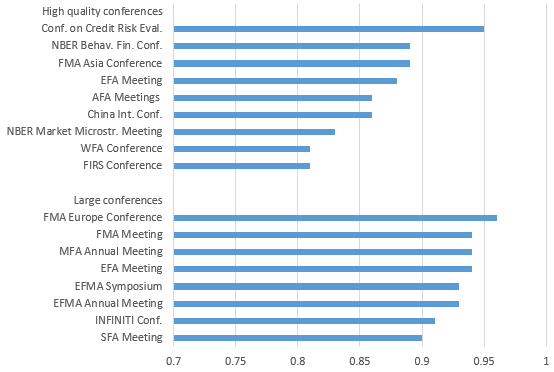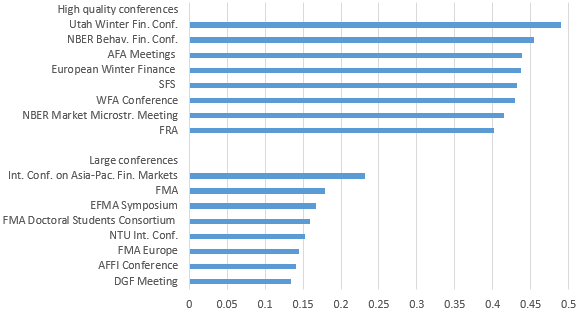Are conferences private parties, and is it worth the effort to break in? In this post, we discussed the relation between attending the right conference and subsequent publication success. Recall that attending prestigious conferences improves the likelihood of publication in a top Finance journal. But if your aim is to get into any journal, large conferences are almost as good.
Conference openness
In addition to publication success, Reinartz and Urban also consider conference openness in their 2017 Journal of Empirical Finance paper “Finance Conference Quality and Publication Success: A Conference Ranking”. Some conferences have a high share of presenters from a very small number of academic institutions. Hence, it is unlikely that your paper will be accepted if you are not part of this private party. How big is the issue? We display conference openness in Figure 1. The bars give the share of presenters at a given conference not from one of the three universities with most presenters.

Figure 1: Conference openness, measured as the fraction of presenters not associated with one of the top 3 represented universities
Figure 1 shows that even top conferences such as the WFA, AFA, or EFA are rather open parties. E.g., more than 80% of presenters at the WFA are not from the three universities with most presenters. Large conferences are even more inclusive. At least 90% of presenters are from outside of the three universities with most presenters.
The downside of conference openness
So, is it worth the effort to get your paper into a high quality conference that is not open? Should you try to break into such a private party? To evaluate this, we weight the publication probability from the previous post with the openness measure from Figure 1. Figure 2 gives this weighted probability.

Figure 2: Fraction of papers subsequently published in an A-ranked journal, weighted by openness
Even when adjusting for openness, papers from high-quality conferences still have a considerably higher publication probability in A journals. The average weighted publication success for these conferences equals 0.31, compared to 0.13 for large conferences. A t-test shows that the difference is statistically significant.
Take-away: No shortcuts when you aim high!
In summary, there is no short-cut: If you want to get into a high-quality journal, and to get accepted at a high-quality conference, you must deliver high-quality research. The best parties may be more open than you think!

You may also like